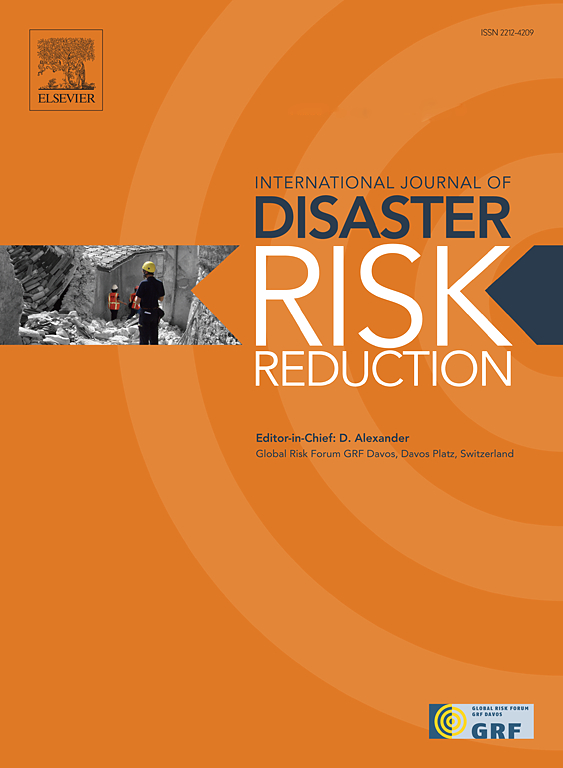来自社交媒体视频的街道尺度水动力估计:城市洪水数据收集的系统方法
IF 4.2
1区 地球科学
Q1 GEOSCIENCES, MULTIDISCIPLINARY
International journal of disaster risk reduction
Pub Date : 2025-03-21
DOI:10.1016/j.ijdrr.2025.105419
引用次数: 0
摘要
越来越多的证据表明,气候变化和城市化加剧了洪水的影响。在这一框架下,洪水模型在支持洪水动态分析方面起着关键作用,特别是在城市地区。该主题的最新进展使详细的街道级研究成为可能,为洪水重建、临近预报和预测提供了巨大的潜力。然而,由于洪水数据的有限可用性,水动力模型的校准和验证面临挑战。最近的研究强调了社交媒体作为城市洪水分析的宝贵资源的潜力,但仍然存在重大挑战,特别是在利用视频数据检索洪水特征方面,导致大量潜在有用信息的丢失。为了解决这一问题,本文提出了一个五步工作流程,用于系统研究和提取社交媒体上上传的洪水相关视频中的关键水动力变量。该程序的目的是检索洪水特征的扩散和质量控制估计,以支持水动力学建模和减少由于缺乏现场测量而造成的差距。该工作流程在2020年发生在克罗托内(意大利南部)的洪水中进行了测试。研究结果强调了拟议程序为洪水影响评估提供详细数据的潜力,为改进街道水动力研究和模型验证铺平了道路。这种方法不仅可以增强数据集的质量控制,而且还允许限制信息丢失,这对于支持更广泛的分布式验证至关重要。本文章由计算机程序翻译,如有差异,请以英文原文为准。
Street-scale hydrodynamic estimation from social media videos: A systematic approach to urban floods data collection
An increasing number of evidence highlights how climate change and urbanization are contributing to exacerbate floods impacts. In this framework, flood modelling assumes a key role in supporting the analysis of floods dynamics, especially in urban areas. Recent advances in this topic enabled detailed street-level studies, offering significant potential for flood reconstruction, nowcasting, and forecasting. However, calibration and validation of hydrodynamic models face challenges due to limited availability of flood data. Recent studies highlighted the potential of social media as a valuable resource for urban flood analysis, yet significant challenges persist, particularly in leveraging videos data to retrieve floodwater characteristics, leading to the loss of a relevant amount of potentially useful information. In this paper, to tackle this issue, a five-step workflow for the systematic research and extraction of key hydrodynamic variables from flood-related videos uploaded on social media is proposed. The aim of this procedure is the retrieval of diffused and quality-controlled estimates of floodwater characteristics to support hydrodynamic modelling and dampening the gap due to the lack of field measurements. The workflow was tested to the flood occurred in 2020 in the city of Crotone (southern Italy). The results underscore the potential of the proposed procedure to provide detailed data for flood impact assessment, paving the way for improved street-level hydrodynamic studies and model validation. This approach not only could enhance the quality control of the dataset but also allows for the limitation of information loss, which is critical for supporting a broader distributed validation.
求助全文
通过发布文献求助,成功后即可免费获取论文全文。
去求助
来源期刊

International journal of disaster risk reduction
GEOSCIENCES, MULTIDISCIPLINARYMETEOROLOGY-METEOROLOGY & ATMOSPHERIC SCIENCES
CiteScore
8.70
自引率
18.00%
发文量
688
审稿时长
79 days
期刊介绍:
The International Journal of Disaster Risk Reduction (IJDRR) is the journal for researchers, policymakers and practitioners across diverse disciplines: earth sciences and their implications; environmental sciences; engineering; urban studies; geography; and the social sciences. IJDRR publishes fundamental and applied research, critical reviews, policy papers and case studies with a particular focus on multi-disciplinary research that aims to reduce the impact of natural, technological, social and intentional disasters. IJDRR stimulates exchange of ideas and knowledge transfer on disaster research, mitigation, adaptation, prevention and risk reduction at all geographical scales: local, national and international.
Key topics:-
-multifaceted disaster and cascading disasters
-the development of disaster risk reduction strategies and techniques
-discussion and development of effective warning and educational systems for risk management at all levels
-disasters associated with climate change
-vulnerability analysis and vulnerability trends
-emerging risks
-resilience against disasters.
The journal particularly encourages papers that approach risk from a multi-disciplinary perspective.
 求助内容:
求助内容: 应助结果提醒方式:
应助结果提醒方式:


